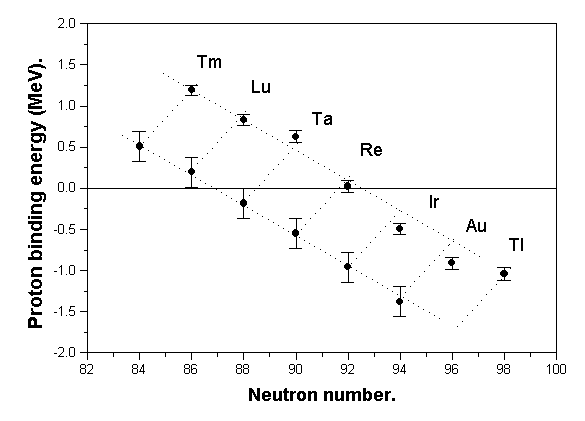
( in collaboration with YASNAPP-group of JINR - Dubna, Russia )
In order to determine the nuclear stability line against the radioactive
decay with emission of the monochromatic proton, it is necessary to reveal
cases when the binding energy of the proton becomes negative.
Direct measurements of nuclide masses near this line are very difficult.
Nuclei with large neutron deficiency in the region A > 150 are mostly alpha emitters. It gives a possibility to obtain the data on masses of these nuclei near the proton drip line using energies of alphas in long alpha decay chains.
This work can be done in two steps:
"Study of short-lived nuclei in the region Z=59-68",
Z.Phys., A310, 247 (1983).
using the intrinsic germanium detector Ge(HP) to study positron spectra
of nuclei in the ends of alpha chains.
The obtained values of endpoint energies of positron spectra and derived
isobar mass differences allowed us to determine MASSES of nuclides at the
bottom of chains:
148 Dy, 149 Dy, 149 Ho, 150 Ho, 151 Ho, and 152 Ho
Using these data and energies of alpha particles, we have calculated masses of nuclides bound in alpha chains and as the result the values of the last proton binding energies ( Bp ) for a number of nuclides ( see Fig. )

It follows from the figure that the nuclides
175 Au, 169 Ir, 171 Ir, 165 Re and probably 161 Ta
Using the obtained systematics for the neighbour nuclei it is possible to make the conclusion that nuclides
176 Au, 177 Au, 170 Ir and 166 Re
are also the proton emitters, and
178 Au, 172 Ir, 167 re, 156 Lu
could be considered as possible candidates for this type of decay.
For nuclides with even Z numbers the pairing effect shifts the drip line toward the larger excess of protons.
The obtained information allows us to locate the proton drip line. In this region of nuclei it runs ( for odd Z nuclides ) through
178 Au, 172 Ir, 167 Re, 161 Ta, 156 Lu and 151 Tm